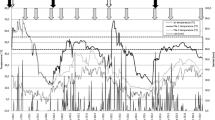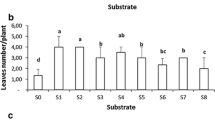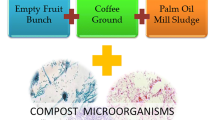Abstract
Composting processes largely depends on microbial activity, but a small amount of data is available about the role of different microbial groups and the potential use of mature composts based on highly lignocellulosic organic materials. In this work microbiological and physico-chemical analyses were carried out aiming to evaluate microbial, physiological and agronomic characteristics of a novel kind of compost obtained from chestnut wastes and used as substrate for tomato (Lycopersicon esculentum Mill.) seedling production. After 345 days of composting, mature compost showed a temperature of 24 °C, pH of 6.9, and a water activity of 0.95. Microbial characterization of hemicellulolytic, cellulolytic and ligninolytic groups in compost showed a different trend during composting process but all were found at a high concentration in the mature compost (106–107 CFU g−1), as well as free-living (N2)-fixing bacteria and Pseudomonas spp. Porosity was 58%, while the value of water holding capacity and compost moisture reached 290 mL L−1 and 40.8%, respectively. Our compost used as substrate for tomato growth, elicited on plantlets a reduction of pigments (chlorophylls and carotenoids) especially for chlorophyll a (594.45 ± 30.25 μg g−1 FW) compared to the control (1064.52 ± 55.05 μg g−1 FW). Moreover, the compost markedly influenced plant antioxidants capacity and stress response observing an increase of the catalase from 17.4 ± 0.15 to 20.3 ± 0.84 µmol H2O2 min−1 mg−1 protein, ascorbate peroxidase activity from 1135 ± 33 to 3213 ± 52 µmol AsA min−1 mg1 protein and ascorbate oxidase activity from 313 ± 8.2 to 1840 ± 29 µmol AsA min−1 mg1 protein in plants grown on 100% peat and 100% compost, respectively.



Similar content being viewed by others
References
Lemaire, J.: Dossier castagno. Sherwood 151, 13–16 (2009)
INFC: The second Italian National Forest Inventory. http://www.sian.it/inventarioforestale/jsp/home_en.jsp (2005)
Schwarz, M., Preti, F., Giadrossich, F., Lehmann, P., Or, D.: Quantifying the role of vegetation in slope stability: a case study in Tuscany (Italy). Ecol. Eng. 36, 285–291 (2010)
Maximising the yield of biomass from residues of agricultural crops and biomass from forestry. Final report. Project number: BIENL15082. https://ec.europa.eu/energy/sites/ener/files/documents/Ecofys%20-%20Final_%20report_%20EC_max%20yield%20biomass%20residues%2020151214.pdf (2016)
Medina, J., Monreal, C., Barea, J.M., Arriagada, C., Borie, F., Cornejo, P.: Crop residue stabilization and application to agricultural and degraded soils: a review. Waste Manag. 42, 41–54 (2015)
Misra, R.V., Roy, R.N., Hiraoka, H.: On farm composting methods. Land and Water Discussion Paper. Food and Agriculture Organization of the United Nations, Rome, Italy (2003)
Paradelo, R., Moldes, A.B., Barral, M.T.: Evolution of organic matter during the mesophilic composting of lignocellulosic winery wastes. J. Environ. Manag. 16, 18–26 (2013)
Roca-Pérez, L., Martínez, C., Marcilla, P., Boluda, R.: Composting rice straw with sewage sludge and compost effects on the soil plant system. Chemosphere 75, 781–787 (2009)
Pepe, O., Ventorino, V., Blaiotta, G.: Dynamic of functional microbial groups during mesophilic composting of agro-industrial wastes and free-living (N2)-fixing bacteria application. Waste Manag. 33, 1616–1625 (2013)
Guerra-Rodríguez, E., Alonso, J., Melgar, M.J., Vázquez, M.: Evaluation of heavy metal contents in co-composts of poultry manure with barley wastes or chestnut burr/leaf. Chemosphere 65, 1801–1805 (2006)
Ventorino, V., Parillo, R., Testa, A., Aliberti, A., Pepe, O.: Chestnut biomass biodegradation for sustainable agriculture. Bioresources 8, 4647–4658 (2013)
Neklyudov, A.D., Fedotov, G.N., Ivankin, A.N.: Intensification of composting processes by aerobic microorganisms: a review. Appl. Biochem. Microbiol. 44, 6–18 (2008)
Zucconi, F., Pera, A., Forte, M., De Bertoldi, M.: Evaluating toxicity of immature compost. Biocycle 2, 54–57 (1981)
DM 13/09/1999: Metodi ufficiali di analisi chimica del suolo. Gazzetta Ufficiale Supplemento Ordinario n° 248 del 21/10/1999 (1999)
Nelson, D.W., Sommers, L.E.: Total carbon, organic carbon and organic matter. In: Sparks, D.L. (ed.) Methods of Soil Analysis. Part 3—Chemical Methods, pp. 961–1010. Soil Science Society of America Inc, Madison, Wisconsin (1996)
Ventorino, V., Amore, A., Faraco, V., Blaiotta, G., Pepe, O.: Selection of cellulolytic bacteria for processing of cellulosic biomass. J. Biotechnol. 150, S181 (2010)
Ventorino, V., Aliberti, A., Faraco, V., Robertiello, A., Giacobbe, S., Ercolini, D., Amore, A., Fagnano, M., Pepe, O.: Exploring the microbiota dynamics related to vegetable biomasses degradation and study of lignocellulose-degrading bacteria for industrial biotechnological application. Sci. Rep. 5, 8161 (2015)
Pepe, O., Palomba, S., Sannino, L., Blaiotta, G., Ventorino, V., Moschetti, G., Villani, F.: Characterization in the archaeological excavation site of heterotrophic bacteria and fungi of deteriorated wall painting of Herculaneum in Italy. J. Environ. Biol. 32, 241–250 (2011)
Ventorino, V., De Marco, A., Pepe, O., De Santo, A.V., Moschetti, G.: Impact of innovative agricultural practices of carbon sequestration on soil microbial community. In: Piccolo, A. (ed.) Carbon Sequestration in Agricultural Soils. A Multidisciplinary Approach to Innovative Methods, pp. 145–178. Springer, Heidelberg (2012)
Fiorentino, N., Fagnano, M., Adamo, P., Impagliazzo, A., Mori, M., Pepe, O., Ventorino, V., Zoina, A.: Assisted phytoextraction of heavy metals: compost and Trichoderma effects on giant reed (Arundo donax L.) uptake and soil N-cycle microflora. Ital. J. Agron. 8, 244–254 (2013)
Wellburn, A.R.: The spectral determination of chlorophylls a and b, as well as total carotenoids, using various solvents with spectrophotometers of different resolution. J. Plant Physiol. 144, 307–313 (1994)
Bradford, M.M.: A rapid and sensitive method for the quantification of microgram quantities of protein utilizing the principle of protein-dye binding. Anal. Biochem. 72, 248–254 (1976)
García-Limones, C., Hervás, A., Navas-Cortés, J.A., Jiménez-Díaz, R.M., Tena, M.: Induction of an antioxidant enzyme system and other oxidative stress markers associated with compatible and incompatible interactions between chickpea (Cicer arietinum L.) and Fusarium oxysporum, f. sp. ciceris. Physiol. Mol. Plant Pathol. 61, 325–337 (2002)
Fernández-Trujillo, J.P., Nock, J.F., Watkins, C.B.: Antioxidant enzyme activities in strawberry fruit exposed to high carbon dioxide atmospheres during cold storage. Food Chem. 104, 1425–1429 (2007)
Kelleher, B.P., Leahy, J.J., Henihan, A.M., O’Dwyer, T.F., Sutton, D., Leahy, M.J.: Advances in poultry litter disposal technology—a review. Bioresour. Technol. 83, 27–36 (2002)
Fernandes, L., Zhan, W., Patni, N.K., Jui, P.Y.: Temperature distribution and variation in passively aerated static compost piles. Bioresour. Technol. 48, 257–263 (1994)
De Boodt, M., Verdonck, O., Cappaert, I.: Method for measuring the water release curve of organic substrates. Acta Hortic. 37, 2054–2062 (1974)
Ryckeboer, J., Mergaert, J., Coosemans, J., Deprins, K., Swings, J.: Microbiological aspects of biowaste during composting in a monitored compost bin. J. Appl. Microbiol. 94, 127–137 (2003)
Van der Heijden, M.G., Bardgett, R.D., van Straalen, N.M.: The unseen majority: soil microbes as drivers of plant diversity and productivity in terrestrial ecosystems. Ecol. Lett. 11, 296–310 (2008)
Herrmann, R.F., Shann, J.F.: Microbial community changes during the composting of municipal solid waste. Microb. Ecol. 33, 78–85 (1997)
Amore, A., Pepe, O., Ventorino, V., Birolo, L., Giangrande, C., Faraco, V.: Industrial waste based compost as a source of novel cellulolytic strains and enzymes. FEMS Microbiol. Lett. 339, 93–101 (2013)
Huang, D.L., Zeng, G.M., Feng, C.L., Hu, S., Lai, C., Zhao, M.H., Su, F.F., Tang, L., Liu, H.L.: Changes of microbial population structure related to lignin degradation during lignocellulosic waste composting. Bioresour. Technol. 101, 4062–4067 (2010)
Amore, A., Pepe, O., Ventorino, V., Birolo, L., Giangrande, C., Faraco, V.: Cloning and recombinant expression of a cellulase from the cellulolytic strain Streptomyces sp. G12 isolated from compost. Microb. Cell Fact. 11, 164 (2012)
Loveland, P., Webb, J.: Is there a critical level of organic matter in the agricultural soils of temperate regions: a review. Soil Tillage Res. 70, 1–18 (2003)
Ishii, K., Fukui, M., Takii, S.: Microbial succession during a composting process as evaluated by denaturing gradient gel electrophoresis analysis. J. Appl. Microbiol. 89, 768–777 (2000)
De Angelis, K.M., Allgaier, M., Chavarria, Y., Fortney, J.L., Hugenholtz, P., Simmons, B., Sublette, K., Silver, W.L., Hazen, T.C.: Characterization of trapped lignin-degrading microbes in tropical forest soil. PLoS ONE 6, e19306 (2011)
Xie, G.H., Cai, M.Y., Tao, G.C., Steinberger, Y.: Cultivable heterotrophic N2-fixing bacterial diversity in rice fields in the Yangtze River Plain. Biol. Fertil. Soils 37, 29–38 (2003)
Orr, C.H., James, A., Leifer, T.C., Cooper, J.M., Cummings, S.P.: Diversity and activity of free-living nitrogen-fixing bacteria and total bacteria in organic and conventionally managed soils. Appl. Environ. Microbiol. 77, 911–919 (2011)
De Bertoldi, M., Vallini, G., Pera, A.: Technological aspects of composting including modelling and microbiology. In: Gasser, J.K.R. (ed.) Composting of Agricultural and Other Wastes, pp. 27–40. Elsevier, London (1985)
Burr, T.J., Caesar, A., Schrolh, M.N.: Beneficial plant bacteria. Crit. Rev. Plant Sci. 2, 1–20 (1984)
Mazzola, M., Granatstein, D.M., Elfving, D.C., Mullinix, K.: Suppression of specific apple root pathogens by Brassica napus seed meal amendment regardless of glucosinolate content. Phytopathology 91, 673–679 (2001)
Tuitert, G., Szczech, M., Bollen, G.J.: Suppression of Rhizoctonia solani in potting mixtures amended with compost made from organic household waste. Phytopathology 88, 764–773 (1998)
Cross, T.: Actinomycetes: a continuing source of new metabolites. Dev. Ind. Microbiol. 23, 1–18 (1982)
Chroni, C., Kyriacou, A., Georgaki, I., Manios, T., Kotsou, M., Lasaridi, K.: Microbial characterization during composting of biowaste. Waste Manag. 5, 1520–1525 (2009)
Chroni, C., Kyriacou, A., Manios, T., Lasaradi, K.E.: Investigation of the microbial community structure and activity as indicators of compost stability and composting process evolution. Bioresour. Technol. 15, 3745–3750 (2009)
Barrena Gómez, R., Vázquez Lima, F., Sánchez Ferrer, A.: The use of respiration indices in the composting process: a review. Waste Manag. Res. 24, 37–47 (2006)
Pascual, J.A., Ayuso, M., Garcia, C., Hernández, T.: Characterization of urban wastes according to fertility and phytotoxicity parameters. Waste Manag. Res. 15, 103–112 (1997)
Heil, M., Baldwin, T.: Fitness costs of induced resistance: emerging experimental support for a slippery concept. Trends Plant Sci. 7, 61–67 (2002)
Ventorino, V., Parillo, R., Testa, A., Viscardi, S., Espresso, F., Pepe, O.: Chestnut green waste composting for sustainable forest management: microbiota dynamics and impact on plant disease control. J. Environ. Manag. 166, 168–177 (2016)
Grime, J.P., Thompson, K., Hunt, R., Hodgson, J.R., Cornelissen, J.H.C., Rorison, I.H., Hendry, G.A.F., Aschenden, T.W., Askew, A.P., Band, S.R., Booth, R.E., Bossard, C.C., Campbell, B.D., Cooper, J.E.L., Davison, A.W., Gupta, P.L., Hall, W., Hand, D.W., Hannah, M.A., Hillier, S.H., Hodkinson, D.J., Jalili, A., Liu, Z., Mackey, J.M.L., Matthews, N., Mowforth, M.A., Neal, A.M., Reader, R.J., Reiling, K., Ross-Fraser, W., Spencer, R.E., Sutton, F., Tasker, D.E., Thorpe, P.C., Whitehouse, J.: Integrated screening validates primary axes of specialisation in plants. Oikos 79, 259–281 (1997)
Jackson, R.B., Caldwell, M.M.: Integrating resource heterogeneity and plant plasticity: modelling nitrate and phosphate uptake in a patchy soil environment. J. Ecol. 84, 891–903 (1996)
Tilman, D.: Plant strategies and the dynamic and structure of plant communities. Princeton University Press, Princeton (1988)
El-Zahaby, H.M., Gullner, G., Király, Z.: Effects of powdery mildew infection of barley on the ascorbate–glutathione cycle and other antioxidants in different host–pathogen interactions. Phytopathology 85, 1225–1230 (1995)
Gönner, M.V., Schlösser, E.: Oxidative stress in interactions between Avena sativa L. and Drechslera spp. Physiol. Mol. Plant Pathol. 42, 221–234 (1993)
de Pinto, M.C., De Gara, L.: Changes in the ascorbate metabolism of apoplastic and symplastic spaces are associated with cell differentiation. J. Exp. Bot. 55, 2559–2569 (2004)
Potters, G., Pasternak, T.P., Guisez, Y., Palme, K.J., Jansen, M.A.K.: Stress-induced morphogenic responses: growing out of trouble? Trends Plant Sci. 12, 98–105 (2007)
Tokunaga, T., Miyahara, K., Tabata, K., Esaka, M.: Generation and properties of ascorbic acid-overproducing transgenic tobacco cells expressing sense RNA for l-galactono-1,4-lactone dehydrogenase. Planta 220, 854–863 (2005)
Iiyama, K., Lam, T.B.T., Stone, B.A.: Covalent cross links in the cell wall. Plant Physiol. 104, 315–320 (1994)
Pomar, F., Caballero, N., Pedreño, M., Ros, Barceló A.: H2O2 generation during the auto-oxidation of coniferyl alcohol drives the oxidase activity of a highly conserved class III peroxidase involved in lignin biosynthesis. FEBS Lett. 529, 198–202 (2002)
Zarra, I., Sanchez, M., Queijero, E., Peña, M.J., Revilla, G.: The cell wall stiffening mechanism in Pinus pinaster Aiton: regulation by apoplastic levels of ascorbate and hydrogen peroxide. J. Sci. Food Agric. 79, 416–420 (1999)
Zheng, X., van Huystee, R.B.: Peroxidase-regulated elongation of segments from peanut hypocotyls. Plant Sci. 81, 47–56 (1992)
Córdoba-Pedregosa, M., González-Reyes, J.A., Canadillas, M., Navas, P., Córdoba, F.: Role of apoplastic and cell-wall peroxidases on the stimulation of root elongation by ascorbate. Plant Physiol. 112, 1119–1125 (1996)
Acknowledgements
This work was supported by “Campania Region—Research Sector”, Program: “Doctorate in Enterprise.” P.O. F.S.E. Campania 2007/2013—University paths aiming at the promotion of scientific research, innovation and technology transfer -CUP E65E12000150006. Regional Council Deliberation no. 182/2011. Priority: IV—Specific Objective 1—Operational Objective 4. Subproject 2. On farm quality compost for forestry productive systems management: sustainability and plant protection.
Author information
Authors and Affiliations
Corresponding author
Rights and permissions
About this article
Cite this article
Parillo, R., Ventorino, V., Pepe, O. et al. Use of Compost from Chestnut Lignocellulosic Residues as Substrate for Tomato Growth. Waste Biomass Valor 8, 2711–2720 (2017). https://doi.org/10.1007/s12649-016-9761-4
Received:
Accepted:
Published:
Issue Date:
DOI: https://doi.org/10.1007/s12649-016-9761-4




